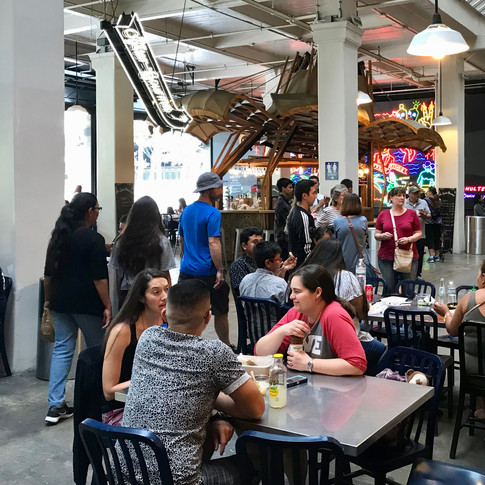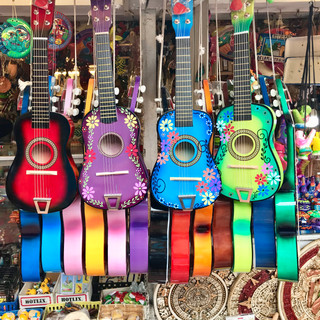FAMILY TOUR - ANGELS FLIGHT RAILWAY and OLVERA STREET
- Ron Hadfield
- Apr 16, 2018
- 9 min read
"While you're working you're using up your life.
Why not be doing something you really enjoy.
~Paul Williams
"Family is the most important thing in the world."
~Princess Diana
"Keep the family together."
~Grandma Grace Hadfield
One of my early ideas when I created my Updated Bucket List for Year 77 was to take the family on a tour of several of the many unique and special attractions located in the Greater Los Angeles area. One such attraction is the Angels Flight Railway located in the Bunker Hill District of downtown Los Angeles. Olvera Street is another special attraction, obviously unique to Los Angeles, and is located very close to Angels Flight. Since the time required to experience Angels Flight is quite short, I decided to include lunch and a walk through Olvera Street as part of our Family Tour.
Everyone in the family is very busy and my effort to schedule a tour in February simply couldn't be arranged because of conflicts. We finally were able to get a pretty good group that could put March 10th on their calendar. Even better, Curran was home from school on that day, and Tracy's friend Jen would be in town. All looked good --- until March 10th when it rained all day, so we had to cancel. Despite the scheduling challenge, a visit to Angels Flight seemed worth it to me so I again solicited dates that would work. Sunday, April 15th seemed to work for most people, so it went on the calendar.
We met at our home at 10:30 am to begin our Family Tour of Angels Flight and Olvera Street. Below is our tour group - From the left is Tracy Clair, Bonnie, Griffin, Heather, Sean, Jenny and Bekah (and me, behind the camera).

BRIEF OVERVIEW:
We drove downtown Los Angeles and rode Angels Flight up and down, then went directly across the street and spent a few minutes at Grand Central Market, then drove a short distance and parked near Union Station and walked through the station to Olvera Street for lunch and some shopping. We were back home in a matter of a few hours, but it was fun to get together, do some visiting, and see a few things that some of us hadn't seen before. I thoroughly enjoyed it and I hope the others did.
Angels Flight Railway:
Our Visit - We all piled into my car and Heather's car and drove to downtown Los Angeles - about a half-hour drive. Angels Flight is on Hill Street between 3rd and 4th and we found a parking lot directly across the street. The photos below, left to right, will tell our story. A view of both rail cars- Olivet at the bottom and Sinai at the top; next our group walking across Hill Street to board Olivet; the next three photos are shots of us as we ride to the top of Bunker Hill - the cars are in excellent condition with fine woodwork; and finally, Griffin and Heather with Olivet in the background.
Click Photo to Enlarge - Use Arrows for Next Photo
From the top of Angels Flight it's a short walk down a flight of stairs to the California Plaza, a peaceful little area in the middle of all the skyscrapers with a few cafes, a water feature and plenty of seating. They have some sort of entertainment on some evenings. The first photo below is a broad photo of the plaza and below are shots of our group by the water.

Click Photo to Enlarge - Use Arrows for Next Photo
Back on top by the Angels Flight station, Sean and Griffin posed by a fountain that holds a dedication plaque placed in 1952. Much has changed since 1952, including a total dismantle of the small railway in 1969, and the replacement and refurbishment in 1996. The dedication is as follows:
Angel's Flight
Built in 1901 by Colonel J.W. Eddy, lawyer, engineer and friend of President Lincoln, Angel's Flight is said to be the world's shortest incorporated railway. The counter-balanced cars, controlled by cables, travel a 33 percent grade for 315 feet. It is estimated that Angel's flight has carried more passengers per mile than any other railway in the world, over a hundred million in its first fifty years. This incline railway is a public utility operating under a franchise granted by the city of Los Angeles.
November 1952
The other photos are our group standing in front of the railway station, located at the top, Bonnie and Griffin showing that we will ride down in the other rail car, Sinai, and finally a shot of us on the way back down to Hill Street.
Click Photo to Enlarge - Use Arrows for Next Photo
The young woman running the train from the station on top was friendly to us and remembered me from a few months ago when I scouted the railway to make sure it would make a good Family Tour. Since I had purchased eight round trip tickets, when we left she gave me eight souvenir tickets.
Click Photo to Enlarge - Use Arrows for Next Photo
A Little Angel Flight History - In 1901, Bunker Hill was one of the most fashionable neighborhoods in Los Angeles, and the cars, Olivet and Sinai, ferried riders up and down the steep slope between Hill and Olive Streets, adjoining the Third Street Tunnel. The beloved landmark was dismantled for “urban renewal” of the area in 1969. In the early 1990s, the Railway was refurbished and relocated a half-block south from its original location, reopening adjacent to California Plaza in 1996. In 2017, the Angels Flight Development Company, was selected to recondition, operate, and maintain the funicular for the next 30 years. Passenger service operations, subject to occasional closures for maintenance, recommenced in August 2017. As short as it is (298 feet), Angels Flight is an essential Los Angeles experience. Since it's original opening in 1901, Angels Flight has given more than 100 million rides along its hillside track.
Copy and paste the following link in your browser to see a 2-minute video of a recent ride on Angels Flight. https://angelsflight.org/portfolio/recent-ride/
The first photo below (from the Railway website) was taken before Bunker Hill was demolished for redevelopment, and the second photo shows how it looks today after being reconditioned and re-positioned.
Click Photo to Enlarge - Use Arrows for Next Photo
Grand Central Market -
Grand Central Market is directly across the street from Angels Flight and has been a downtown landmark since 1917. Sean suggested we stick our head in for a minute to see what was going on and it was well worth our time. Most of us, including me, had never been there before and it was interesting to see. It's a great central location to walk around the L. A. City and sit and people watch. The atmosphere is a blur of sounds and smells. There are obviously plenty of good food options, ranging from burritos to croissants to Asian rice dishes, to many other things I didn't make note of. I know you can get about every kind of beer there is. If you look closely you can pick out Bonnie, Jenny and Heather in the first photo in the 2nd photo row.
Click Photo to Enlarge - Use Arrows for Next Photo
Union Station -
We left the Grand Central Market and drove toward Olvera Street to have lunch, but the traffic there was heavy and the parking lots were full. Union Station is next to Olvera Street and we found a parking lot on the east side of the station that allowed us to walk through the tunnel and see the impressive station on our way to Olvera Street. This was an unplanned, but neat addition, to our tour.

Los Angeles Union Station is the main railway station in Los Angeles, and the largest railroad passenger terminal in the Western United States. It opened in May 1939 as the Los Angeles Union Passenger Terminal, replacing La Grande Station and Central Station. Today, the station is a major transportation hub for Southern California. Three of Amtrak's long distance trains originate and terminate here. The Amtrak California Pacific Surfliner regional trains run frequently to San Diego and also to Santa Barbara and San Luis Obispo. The station is the hub of the Metrolink commuter trains, and several Metro Rail subway and light rail lines serve it as well, with more in construction or planning. The Gold Line runs from Glendora, where Jenny's family and Tracy live, through Monrovia, our home town, and through Arcadia, where Heather's family lives. We can all hop the train for a round-trip to Los Angeles rather than fight the auto traffic.
The architecture of the main terminal is really impressive. The images below show the Waiting Room on the left, which we walked through, and the Original Ticket Lobby, which is currently closed to the public, but rented for filming and special events. There are very nice enclosed outside garden areas on both sides of the Waiting Room.
Click Photo to Enlarge - Use Arrows for Next Photo
The photos below track our progress through Union Station. The first photo shows our group entering the terminal from where we parked the cars. Next is a large mural as we entered. There are many impressive murals throughout the station - I didn't research the background of this one. The third photo shows our group walking through the tunnel toward the main terminal, and the final photo is when we were walking through the Waiting Room.
Click Photo to Enlarge - Use Arrows for Next Photo
Olvera Street -
As we walked out of Union Station, our lunch target was directly across the street. Olvera Street (Calle Olvera) is a historic district in downtown Los Angeles, and a part of El Pueblo de Los Angeles Historic Monument. It was officially founded in 1781 in Los Angeles, and was renamed to Olvera Street in 1877. Many of the Plaza District's Historic Buildings are on Olvera Street, as well as some of the oldest Los Angeles monuments including the Avila Adobe built in 1818, Pelanconi House built in 1857, and the Sepulveda House built in 1887. The tree-shaded, pedestrian mall marketplace with craft shops, restaurants and roving troubadours is a popular tourist destination. The street has been described as a "Top Five" in the "Great Streets of America" journal.
Click Photo to Enlarge - Use Arrows for Next Photo
We decided to have lunch first, and then do a little shopping. The restaurants were crowded but we got into El Paseo Inn more quickly than I expected, given we had a large group. It was busy, but the service was good and it was fun to see and listen to the Mariachis.
Click Photo to Enlarge - Use Arrows for Next Photo
Everyone seemed to enjoy their food and drink, and we had some good visiting.
Click Photo to Enlarge - Use Arrows for Next Photo
Then the finale - shopping! I'm not a good shopper, but I know others enjoy it. Photos in the 1st row below show our group strolling and looking. The first photo in the 2nd row shows Griffin finding a dog friend (a large "doggy bank"), the second photo shows a display that I know caught Griffin's eye because he later ended up with a guitar to take home, and the final photo is of the dancing that was taking place on The Plaza.
This was the end of our Family Tour - it was short in time elapsed, but I think everyone enjoyed it, and we saw more things than were originally planned.
Click Photo to Enlarge - Use Arrows for Next Photo
A Little More (but not important) History of the Railway- Readers of my blog know about my preoccupation with the number seven. I've been continually surprised at how many times that number comes up in reviewing my own history and in researching the history of various activities I've planned for my Year 77. It happened again when I researched the history of Angels Flight Railway and found that there have been seven private operators of the Railway since the beginning.
1. Col. J.W. Eddy received permission from the L.A. City Council to build a funicular (an incline railway) by the 3rd Street tunnel in May 1901. He completed the project and Angels Flight Railway opened December 31, 1901. More than 2,000 people rode the Railway on opening day.
2. Col. Eddy sold Angels Flight to The Funding Company of Los Angeles in 1912.
3. Continental Securities Company purchased the Railway in 1914 and engineer Robert Moore began service as Railway General Manager that year.
4. In 1946, Robert Moore, the General Manager, purchased the Railway from Continental Securities.
5. In 1952, Robert Moore retired, having served the Railway and its passengers from 1914 to 1952, and sold the Railway to Lester Moreland.
6. In 1962, Lester Moreland was given the alternative of selling the Railway to L.A. City or losing the Railway by eminent domain. Moreland sold to the City to allow them to "improve Bunker Hill with urban renewal." The City hired Oliver & Williams Elevator Company as the private operator of the Railway until 1969 while Bunker Hill's old buildings were demolished all around it. In May 1969 the dismantling of the Railway began to make way for the "urban renewal." The plan was for the Bunker Hill Developer to become the seventh private operator, but the developer terminated his right to do this.
7. In 1991, through the efforts of the L.A. Conservancy and others, the City finally began to fulfill the promise it had made during the 1960s to restore Angels Flight Railway. The Angels Flight Railway Foundation was created and the Foundation assumed the rights and obligations of the Bunker Hill Developer and became the seventh private operator of the Railway. The Railway was reopened for operation at its new location, just south of the original location, in February 1996 and has been operating there ever since.
























































































Comments